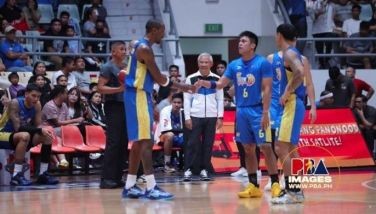Getting reacquainted with San Francisco
SAN FRANCISCO BAY AREA – An eight-hour drive from Los Angeles along the shoreline of California reveals the narrow peninsula of the city of San Francisco jutting out between the Pacific Ocean and San Francisco Bay. This is my second visit to San Francisco after 20 years. I came armed with my fur coat to shield me from the 9 to 12 degrees cold weather and chilly bay wind that constantly blows in the foggy center. This time I first stayed in Hayward next door to Fremont where I was driven from San Francisco international airport through the long San Mateo Bridge that crosses San Francisco Bay. The large Andaya family acquainted me with what is known as the Bay Area made up of the other cities of San Leandro, Oakland, Berkeley closer to Bay Bridge. To the north, the Golden Gate Bridge links the peninsula to Marin County. The BART or Bay Area Rapid Transit lines and freeways served these surrounding areas.
The intriguing spots of the metropolis that tourists frequent
San Francisco seems to be as precious as Hong Kong is to Mainland China. This golden city of 40 hills is scenically topped by Telegraph Hill, Coit Tower and Nob Hill. Visitors and television directors (“The Streets of San Francisco”) prefer to film Russian Hill as a more colorful representative of San Francisco with its most crooked street snaking down the hill, garlanded with fuchsia-pink azalea bushes. The other symbol is the cable or tram, which follows the scenic view coursing through Powell Street. It goes down from the hills to Union Square, where the famous old hotels, department stores and Chinatown cluster together. The other colorful area is Fisherman’s Wharf.
The whole area is charmingly converted to a series of boutiques housed in Ghirardelli Square and an old fishing cannery called The Cannery In Pier 39, where Sonny Andaya took me to lunch at the Fog Harbor Fish House. In spite of the long queue of customers, Engineer Andaya asked for a seat by the window for a good view of the foggy harbor so we waited a bit longer. It was well worth it for with a full view of the foggy harbor and the rock of seals, we enjoyed the house specialty, an excellent steamy Cioppino – tomato stew of very fresh giant crab, fresh fish, shrimps, clams, scallops and mussels. Although I insisted that we share the typical huge American serving order, each portion was still large.
On the other side is Little Italy with its numerous trattorias, ristorantes, antipasti bars and gelato ice cream parlors managed by old-timer Italians, who make up 20% of San Francisco residents.
San Francisco and the sea
On this rainy day, we were forced to stay indoors at the Maritime Museum instead of the Aquatic Park historic walkways and gardens with a cable car turnaround. The visitor center’s exhibits and artifacts tell stories of seafarers on the West Coast. I felt nostalgic about our seafaring history as an archipelago, which used to have 2,000 ports around Luzon, Visayas and Mindanao with the major activities in Manila Bay and Harbor as well as the port of Cebu. Why can’t we have our own exciting Philippine Maritime Museum especially with many overseas Filipino workers plying the oceans of the world.
Across Pier 39 of the Maritime Museum made use of wall paintings and large photographs of the history of San Francisco. While native peoples paddled the bay in reed canoes, European explorers charted the coastline. In 1776 the Spanish settled at Yerba Buena, the Yerba Buena Gardens Convention Center of present-day San Francisco.
In 1849 after the discovery of gold in Sierra Nevada foothills, the world rushed in. That year, over 750 ships arrived in San Francisco. Abandoned they lie today beneath the city’s financial district. “It is a city of ships, piers, and tides,” wrote Chilean journalist Benjamin Vicuña Mac Kenna in 1852. The Gold Rush brought merchants, laborers and craftspeople from around the world. By the 1870s California’s burgeoning grain trade lured big European sailing ships like Balclutha. On San Francisco’s docks the bags were hand-loaded into the holds of sailing ships bound for Europe.
American inter-coastal steamer traffic exploded after the Panama Canal opened in 1914. West Coast shipyards opened to meet the demands of World Wars I and II. For a time, a dazzling array of vessels crowded the San Francisco waterfront. These maritime activities have been transferred to the huge Oakland docks. Today these 39 piers have been converted to restaurants and shops for the regular invasions of tourists. In 1988 Congress established San Francisco Maritime National Historical Park to protect and preserve America’s maritime past.
The sole survivors of the golden age
To mark the completion of the Panama Canal, San Francisco hosted the magical Exposition, which attracted 20 million visitors over 10 months. Neither World War I in Europe nor the beginning of Prohibition in the US could dampen the city’s renewed energy after the 1906 earthquake.
It was described by one highly enthusiastic visitor as “a miniature Constantinople.” The fair was held on land reclaimed from San Francisco Bay, on the site of today’s Marina District. Its impressive pavilions were donated by all the states and by 25 foreign countries and lined a concourse 1 mile (1.6km) long. Dottoressa Maria Montessori, then a guest speaker of American educators, delighted the visitors when she put together kindergarten children in a glass wall Montessori classroom in the Italian pavilion.
Sole survivor of the many grandiose monuments built as part of the 1915 Panama-Pacific Exposition is the Neo-Classical Palace of Fine Arts, as an Expo centerpiece. Inside the Palace is the Exploratorium, one of the most engaging science museums in the US. Established in 1969 by Frank Oppenheimer, whose brother Robert helped develop the atom bomb, it has hundreds of interactive exhibits and a 1,000-seat theater.
Inside the Exploratorium, more than 650 exhibits encourage visitors to explore the world of science and to make discoveries about the senses. Exhibits are divided into 13 subject areas. Tess Coffil, former Secretary of Max, now a resident of Sta Rosa wine valley accompanied me through each of them. Located on the main floor and the mezzanine level, each interactive display was funded by a philanthropist or private foundation.
Across this is the “Jewel City Art from San Francisco’s 1915 Panama Pacific International Exposition” featuring the special art collection of Donna Ewald Huggins de Young.
The encounter with illustrious artists: Karen Gabay and Francis Coppola
Eager to show me the best, close friends Victorino “Nonong” and Nani Franco booked me at Handlery By Union Square Hotel the rest of my stay. Our first date was the Silicon Valley Ballet at San Jose featuring the Christmas ballet, “Nutcracker.” Although I have seen about five versions, this particular production choreographed by highly reputable Filipino ballerina Karen Gabay was awesome. Born in Hawaii of Filipino (Zambales) and American parents she attended the School of American Ballet in New York, then joined the Silicon Valley Ballet when the company was still in its infancy. She has already done 40 ballet productions. Not only is she famous for introducing stunning choreography but complements it with ingenious sets and costumes making this season’s Nutcracker look brand new. A big cast of Asians with the lead ballerinas from Japan, Thailand and Filipino children danced flawlessly with European and American dancers.
The Snow Queen dancers wore such fairy light costumes, which flounced like snowflakes. The Mouse Captain and his soldiers wore elegant top hats while the Russian male dancers looked like they jumped off straight from St. Petersburg. The Chinese and Arabian sets were cleverly lifted in mid-air giving more floor space to the dancers. Nani and I kept nudging each other every time the dancers changed from suite to suite revealing extraordinary costume designs. Ms. Gabay autographed the children’s book of Nutcracker she wrote as the basis for the ballet. She accepted my request for an interview via email and is eager to make a first visit to the Philippines.
As my holiday was ending, Tess and her husband David, a well known memory trainor, took me to lunch at Francis Ford Coppola’s Vineyard in Sta. Rosa. We were enthralled by the museum of memorabilia he put together right beside the restaurant “Rustic – Francis’s Favorites.” First we went through the well laid-out museum featuring life like, fully costumed characters of Bram Stoker’s Dracula, Apocalypse Now, Tucker, the Man and his Dream (one of the only 50 Tucker cars assembled, the red one was revolving on display), Frankenstein. The three and a half years spent filming Apocalypse Now in the Philippines featured the most numerous memorabilia for he persisted in finishing it even when a typhoon destroyed his sets and one of the leading men had a heart attack.
Francis and Eleanor Coppola discovered Blancaneaux Lodge in 1981 while searching for a lost paradise rumored to be hidden in the mountains of Pine Ridge. When he found it abandoned, he jumped into the falls and thought it was a wonderful place to write. For more than a decade he used this as a family retreat before he opened his tropical paradise to the public in 1993.
The Coffils and I concluded our visit choosing Francis’s favorite dishes from a list of 10, the “Habit -Forming Ribs” 1 ½ inch thick with its sweet and savory combination and “Mrs, Scorsese’s Lemon chicken.”
Everybody cannot help but leave their heart in San Francisco
There is a Spanish credo: “Salud y peseatas e tiempo para gastarla.” It believes that happiness is not just having health and money but most of all time to spend it. The excitement and beauty of San Francisco compels the visitors to leave their hearts in this city by the bay and reminds the tourists to have enough time to enjoy them.
(For feedback email at [email protected])
- Latest






























